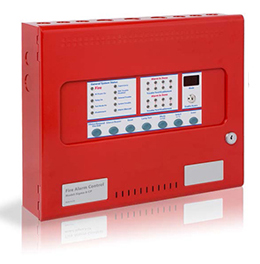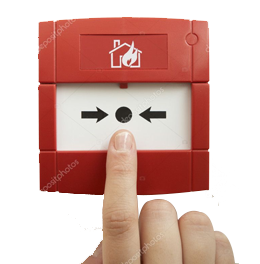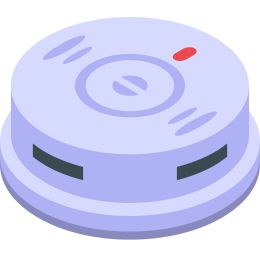
A conventional fire alarm is a safety system designed to detect and alert you to any signs of fire within your premises.
Read more
Addressable Fire Alarm Systems is a great way to provide security and safety for the people in your home, business..
Read more
If You Are Looking For Smoke Detector Installation Services In Delhi, You May Want To Consider Reaching...
Read moreFire alarm systems are crucial for the safety of people and property. They are designed to detect and alert occupants in the event of a fire, allowing for a prompt evacuation and minimizing potential damage.
Typically, a fire alarm system consists of smoke detectors, heat detectors, and sometimes flame detectors strategically placed throughout a building. When these sensors detect signs of a fire, they trigger the alarm system.
Modern fire alarm systems often come with advanced features such as automatic notification to emergency services, integration with sprinkler systems, and even smart technologies that allow remote monitoring and control.
One of the most significant advantages of fire alarm systems is their ability to detect fires at an early stage. This early detection allows for quicker response times, increasing the chances of extinguishing the fire or evacuating occupants before it spreads.
2. Life Safety:The primary purpose of fire alarm systems is to protect human life. By providing timely alerts, these systems enable occupants to evacuate safely, minimizing the risk of injuries or fatalities.
3. Property Protection:Fire alarm systems not only safeguard lives but also protect property. Early detection allows for faster response from firefighting services, reducing the extent of damage to buildings and belongings.
4. 24/7 Monitoring:Many fire alarm systems are equipped with 24/7 monitoring services. This ensures constant vigilance and immediate response to any detected threats, even when the building is unoccupied.
5. Integration with Other Systems:Modern fire alarm systems can be integrated with other building management systems, such as HVAC and access control. This integration allows for a more comprehensive approach to safety and security.
6. Compliance with Regulations:Installing a fire alarm system is often a legal requirement in many jurisdictions. Compliance with these regulations not only ensures the safety of occupants but also protects property owners from legal liabilities.
7. Reduced Insurance Costs:Insurance companies often offer lower premiums to properties with installed fire alarm systems. The reduced risk of extensive fire damage makes these properties less of an insurance liability.
8. Easy Maintenance:Routine maintenance of fire alarm systems is relatively straightforward. Regular checks and servicing ensure that the system remains in optimal working condition, providing peace of mind to property owners and occupants.
9. Varied Detection Methods:Fire alarm systems use various detection methods, including smoke detectors, heat detectors, and flame detectors. This diversity allows for the detection of different types of fires, enhancing overall effectiveness.
10. Scalability:Fire alarm systems can be scalable, making them suitable for different sizes and types of buildings. Whether it's a small residential unit or a large commercial complex, there are fire alarm solutions to meet specific needs.
One of the significant challenges with fire alarm systems is the occurrence of false alarms. These can be triggered by cooking smoke, dust, or other non-threatening factors, leading to complacency among occupants and emergency responders.
2. Installation Costs:The initial cost of installing a fire alarm system can be relatively high. This includes the purchase of equipment, wiring, and professional installation services. For some property owners, this upfront cost can be a deterrent.
3. Maintenance Costs:While routine maintenance is generally straightforward, it still incurs additional costs. Batteries need replacement, sensors require calibration, and any malfunctioning components must be promptly addressed.
4. Technological Complexity:Advanced fire alarm systems can be technologically complex. This complexity may lead to challenges in understanding and operating the system for some users, necessitating proper training.
5.Dependency on Power:Most fire alarm systems rely on electricity. In the event of a power outage, the system may switch to a battery backup. However, if the batteries are not adequately maintained or if the outage is prolonged, the system's effectiveness could be compromised.
6. Sensitivity to Environmental Factors:Environmental factors, such as extreme temperatures, humidity, or dust, can impact the performance of fire alarm systems. Regular calibration and maintenance are necessary to ensure optimal functioning in varied conditions.
7.Limited Effectiveness in Certain Fire Types:While fire alarm systems are generally effective, they may have limitations in certain scenarios, such as detecting slow smoldering fires. The choice of detection methods and sensors plays a crucial role in addressing these limitations.
8. Occupant Response:The effectiveness of a fire alarm system also relies on the timely and appropriate response of occupants. In some cases, individuals may not take alarms seriously, assuming they are false, leading to delays in evacuation.
9. Risk of Tampering or Vandalism:In some settings, there is a risk of intentional tampering or vandalism of fire alarm systems. This can compromise the system's reliability and effectiveness.
10. Obsolete Technology:As technology advances, older fire alarm systems may become obsolete. Upgrading to newer systems may be necessary to ensure compatibility with the latest detection methods and communication protocols.
Fire safety is paramount in any environment to prevent accidents, injuries, and loss of life. Here are some points of fire safety rules covering various aspects:
1. Install smoke detectors in every room and hallway, ensuring they are in good working condition.
2. Test smoke detectors monthly and replace batteries annually.
3. Develop and practice a fire escape plan with your household or colleagues.
4. Keep emergency numbers, including the fire department, easily accessible.
5. Educate everyone in your household or workplace about fire safety protocols.
6. Have multiple fire extinguishers placed strategically throughout the property.
7. Know the types of fires each extinguisher is suitable for and how to use them.
8. Ensure that fire extinguishers are regularly inspected and maintained.
9. Keep flammable materials away from heat sources.
10. Store flammable liquids in approved containers and in designated areas.
11. Never leave cooking unattended, especially when using the stovetop.
12. Keep flammable items like towels and oven mitts away from the stovetop.
13. Turn off cooking appliances when not in use.
14. Keep a lid nearby when cooking to smother grease fires.
15. Keep combustible materials at least three feet away from heaters and heat sources.
16. Unplug electrical appliances when not in use.
17. Inspect electrical cords for damage and replace them if necessary.
18. Do not overload electrical outlets or extension cords.
19. Use surge protectors for electronic equipment.
20. Avoid using damaged or frayed cords and cables.
21. Never run electrical cords under rugs or furniture.
22. Keep matches, lighters, and candles out of reach of children.
23. Use candles in sturdy holders and never leave them unattended.
24. Extinguish candles before leaving a room or going to sleep.
25. Avoid smoking indoors, especially in bed or when drowsy.
26. Use deep, sturdy ashtrays and empty them regularly.
27. Always dispose of smoking materials properly and safely.
28. Maintain and clean chimneys and heating appliances regularly.
29. Ensure proper ventilation for all heating systems.
30. Inspect and clean dryer vents to prevent lint buildup.
31. Install spark arresters on chimneys and stovepipes.
32. Keep fireplaces clear of debris and flammable materials.
33. Ensure fireplaces have a protective screen or glass door.
34. Store firewood at least 30 feet away from buildings.
35. Regularly clear brush and vegetation around your property to create a fire break.
36. Keep a garden hose, buckets of water, or fire extinguisher nearby when burning yard waste.
37. Observe local burning ordinances and restrictions.
38. Never leave outdoor fires unattended, and fully extinguish them before leaving.
39. Use caution when handling fireworks and follow all safety instructions.
40. Keep a first aid kit readily available.
41. Install carbon monoxide detectors in your home.
42. Educate everyone in your household about carbon monoxide poisoning symptoms.
43. Have heating systems and fuel-burning appliances inspected annually.
44. Use caution when storing and handling propane tanks.
45. Ensure proper ventilation when using gas-powered equipment indoors.
46. Store gasoline and other flammable liquids in approved containers in well-ventilated areas.
47. Keep all exits clear of obstructions.
48. Ensure windows can be easily opened in case of emergency.
49. Maintain clear and visible exit signs.
50. Conduct regular fire drills in residential and workplace settings.
51. Designate a meeting place outside where everyone will gather after evacuating.
52. Keep fire hydrants clear of debris and vegetation.
53. Do not block fire lanes or emergency vehicle access.
54. Maintain clear access to fire escapes and exits.
55. Keep fire doors closed to prevent the spread of flames and smoke.
56. Know the location of fire alarms and how to use them.
57. Never re-enter a burning building for any reason.
58. If trapped in a burning building, stay low to the ground where the air is less toxic.
59. Seal doors and vents with towels or clothing to prevent smoke from entering.
60. Signal for help from windows using a flashlight or brightly colored cloth.
61. If your clothes catch fire, stop, drop, and roll to smother the flames.
62. Teach children how to dial emergency services and what information to provide.
63. Teach children how to escape on their own in case adults are incapacitated.
64. Encourage workplace safety training and fire prevention programs.
65. Properly dispose of flammable materials and waste.
66. Store hazardous materials in approved containers and areas.
67. Label hazardous materials clearly.
68. Store and handle combustible dust properly to prevent explosions.
69. Maintain good housekeeping practices to minimize fire hazards.
70. Use caution when refueling hot equipment or vehicles.
71. Properly store and handle batteries to prevent fires and explosions.
72. Avoid using damaged or leaking batteries.
73. Handle and dispose of ashes from fires and grills safely.
74. Keep fire hydrants accessible and clear of obstructions.
75. Follow manufacturer instructions for all appliances and equipment.
76. Inspect heating systems, including furnaces and boilers, annually.
77. Keep vents and flues clear of debris and obstructions.
78. Ensure electrical panels are accessible and not blocked by storage.
79. Store oily rags in airtight containers away from heat sources.
80. Use caution when using power tools and equipment.
81. Use caution when using soldering irons and welding equipment.
82. Keep fire blankets and extinguishers near areas prone to electrical fires.
83. Know the location and operation of main gas and water shut-off valves.
84. Keep access clear to firefighting equipment like fire hydrants and standpipes.
85. Practice proper storage of household chemicals and hazardous materials.
86. Keep a list of emergency contacts and important documents in a fireproof safe.
87. Ensure all doors and windows can be easily opened from the inside.
88. Keep hallways and stairwells clear of clutter.
89. Have a backup power source such as a generator in case of electrical failure.
90. Use caution when using portable space heaters.
91. Keep a fire extinguisher in the kitchen and garage.
92. Clean the lint trap in the dryer after every use.
93. Regularly inspect and maintain electrical wiring.
94. Install child safety covers on electrical outlets.
95. Teach children not to play with matches or lighters.
96. Keep combustible materials away from heating sources.
97. Keep fire exits clearly marked and unobstructed.
98. Train employees on proper fire safety procedures.
99. Develop an emergency evacuation plan for your workplace.
100. Regularly review and update your fire safety plan and procedures.
© Copyright © 2021 Technohead.in All Rights Reserved